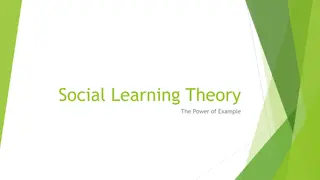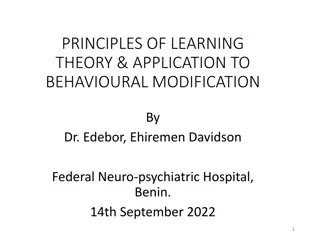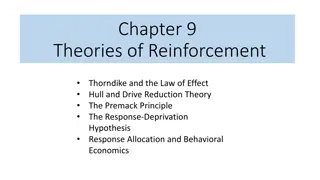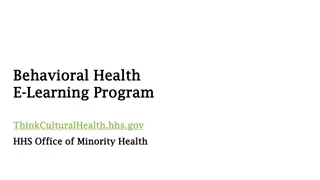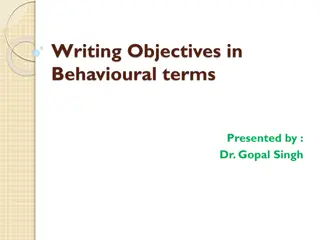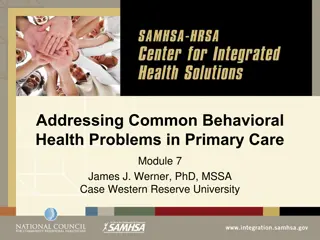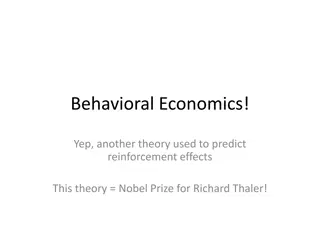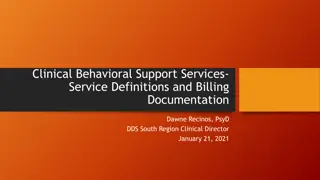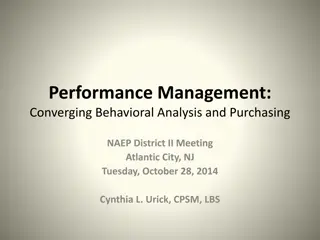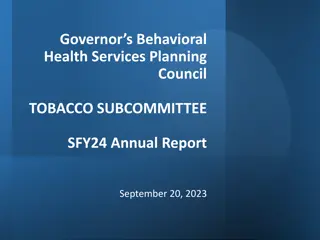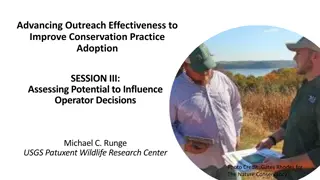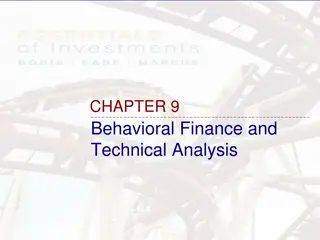Understanding Behavioral Theory in Education
This module delves into the Behavioral Theory in education, discussing key concepts, practical applications, and strategies for implementation. Developed in collaboration with education experts, it offers tools, resources, and activities to enhance understanding and application of behavior support principles. Ideal for pre-service and experienced teachers looking to improve their skills and outcomes in the classroom.
Download Presentation

Please find below an Image/Link to download the presentation.
The content on the website is provided AS IS for your information and personal use only. It may not be sold, licensed, or shared on other websites without obtaining consent from the author. Download presentation by click this link. If you encounter any issues during the download, it is possible that the publisher has removed the file from their server.
E N D
Presentation Transcript
Module 1 Module 1 Behavioral Theory I Behavioral Theory I Jennifer Freeman, PhD Don Briere, PhD Brandi Simonsen, PhD
Acknowledgements Acknowledgements Much of the content shared in this module was developed by members of the OSEP-funded National Technical Assistance Center for Positive Behavioral Interventions and Supports. Thank you to: Thank you to: Members of classroom workgroup: Members of classroom workgroup: Brandi Simonsen, Jennifer Freeman, Jessica Swain-Bradway, Robert Putnam, Heather George, Steve Goodman, Barb Mitchell, Kimberly Yanek, Kathleen Lane & Jeffrey Sprague Members of the Northeast PBIS Network: Members of the Northeast PBIS Network: Susannah Everett, Adam Feinberg, George Sugai, Brandi Simonsen & Jennifer Freeman
Orientation to Module Tools and Resources Module Videos Module Workbook Module Readings and Additional Resources
Orientation to Module Elements Activities Discussion Board Post Stop and Jot Evaluate an example Workbook Quiz Module Quiz Self Assessment Do you know the basic content presented in this module?
Activity 1.1: Stop and Jot Activity 1.1: Stop and Jot What do you know about behavior support? What do you know? What do you want to know? Please pause the video to complete Activity 1.1 Please pause the video to complete Activity 1.1
Getting the Most Out of This Module Pre-service New Teachers Experienced Teachers Become fluent with content and basic theory Look for examples of implementation in your clinic placements Video record or ask for feedback on your implementation of key practices during your student teaching Focus on moving from knowledge to practice Set implementation goals and either self- monitor or ask for peer/coach feedback on your use of key skills When a practice isn t working, use your understanding of theory to help you modify or intensify a practice to improve outcomes Use activities as a self-reflection opportunity Set a new implementation goal for yourself Consider how you might coach or teach the skills/content to a new teacher in your building Review resources provided to extend your learning with respect to culturally and contextually relevant implementation
DBI for Intensive Academic Need 5 Critical Features of Classroom 5 Critical Features of Classroom Management Management Implement with Fidelity Implement with Fidelity Progress Monitor _ _ + + Diagnostic Assessment Increased frequency, duration, or precision of 5 Critical Features of Classroom Management Intervention Adaptations Progress Monitor _ _ + + DBI for behavior
Module Objectives Module Objectives By the end of Module 1 you should be able to: Part 1 Describe the rationale and importance of behavior support Part 2 Define and identify elements of basic behavioral theory Three-term contingency Part 3 Reinforcement Punishment Extinction Part 4 Define and describe function of behavior
Behavioral Theory I Behavioral Theory I Part 1 Why do we need to focus on behavior?
United States, we have a problem! United States, we have a problem! 12% 12% of beginning public school teachers leave within their first 2 years 50% 50% leave within their first 5 years (Boyd, Grossman, Ing, Lankford, Loeb, & Wyckoff, 2011; DeAngelis, & Presley, 2011; Feng, 2006; Henke, Zahn, & Carroll, 2001; Ingersoll, 2001; Ingersol, Merril, May, 2012; Johnson & Birkeland, 2003; Ingersoll & Smith, 2003; Kaiser & National Center for Educational Statistics, 2011; Kukla- Acevedo, 2009; Luekens, Lyter, Fox, & Changler, 2004; Smith & Ingersoll, 2004; Torres, 2012; Zabel & Zabel, 2002)
Why do teachers leave? Why do teachers leave? Most consistently listed factors: Most consistently listed factors: Lack of pedagogical training School environment Poor student behavior and motivation Inadequate pre-service training on classroom management Lack of support and training for handling student behaviors (Boyd, Grossman, Ing, Lankford, Loeb, & Wyckoff, 2011; Chesley & Jordan, 2012; Feng, 2006; Halford, 1998; Henke, Zahn, & Carroll, 2001; Ingersoll, 2001; Ingersol, Merril, May, 2012; Johnson & Birkeland, 2003; Kukla-Acevedo, 2009; Lane, Wehby, & Barton-Arwood, 2005; Luekens, Lyter, Fox, & Changler, 2004; Stough, 2006; Torres, 2012; Zabel & Zabel, 2002)
So teaching is hard So teaching is hard . . why do you do it? why do you do it?
Activity 1.2: Stop and Jot Activity 1.2: Stop and Jot Effective teacher behaviors Use this video to prompt your thinking Then respond to the following question in your workbook: https://www.youtube.com/w atch?v=VXCl2fMsdTU What 3 words would you use to describe the classroom environment of the most effective teacher you ve had? Please pause the video to complete Activity 1.2 Please pause the video to complete Activity 1.2
Our job in this course is to boil down some of these big concepts into concrete skills, which when implemented translate back into great teaching
Goal of Teaching Goal of Teaching Student Student Achievement Achievement Good Good Teaching Teaching Classroom Classroom Management Management Behavior problems disrupt learning. Engaging instruction prevents behavior problems. (Gest & Gest, 2005; Stronge, Ward, & Grant, 2011)
In Other Words In Other Words . . Support Student Behavior to Promote Student Success Support Student Behavior to Promote Student Success Effective behavior support leads to: Increase in Increase in Appropriate Appropriate Behavior Behavior Increase in Increase in Academic Academic Performance Performance Decrease in Decrease in Inappropriate Inappropriate Behavior Behavior Examples: Examples: On-Task Prosocial Engagement Achievement Examples: Off-Task Disruptive (Lewis et al., 2004; Simonsen et al., 2008)
Bottom Line Bottom Line Classroom & behavior management is a Classroom & behavior management is a critical component of student success critical component of student success The good news is we know what this looks like! The good news is we know what this looks like! (Gest & Gest, 2005; Stronge, Ward, & Grant, 2011)
Research Research- -Based Classroom Based Classroom Management Management 1. 1. Maximize structure in your classroom. Maximize structure in your classroom. 2. 2. Post, teach, review, monitor, and reinforce a Post, teach, review, monitor, and reinforce a small number of positively stated expectations. small number of positively stated expectations. 3. 3. Actively engage students in observable ways. Actively engage students in observable ways. 4. 4. Establish a continuum of strategies to Establish a continuum of strategies to acknowledge appropriate behavior. acknowledge appropriate behavior. 5. 5. Establish a continuum of strategies to Establish a continuum of strategies to respond to inappropriate behavior. respond to inappropriate behavior. (Simonsen, Fairbanks, Briesch, Myers, & Sugai, 2008)
But we dont seem to be using them But we don t seem to be using them Specific Praise General Praise OTR Corrective/ Reprimand Reinke et al. (2012)1 Scott et al. (2011)2 Hirn & Scott (2014)3 Pas et al. (2015)4 0.13 0.43 1.43 0.67 0.06 (overall positive) 0.57 0.07 0.47 Group 0.06 Indiv. 0.03 (overall positive) 0.08 0.12 (approval) 0.93 0.27 1 Based on observations of 33 elementary teachers 2 Based on > 1000 observations of elementary and high school teachers elementary and high school teachers in schools not identified as implementing PBIS 3 Based on 827 observations of high school teachers high school teachers 4 Based on observations of 1262 high school teachers 1262 high school teachers prior to PBIS implementation 33 elementary teachers in schools implementing PBIS with fidelity implementing PBIS with fidelity
Do states require classroom Do states require classroom management instruction? management instruction? Does it have to be research based? Does it have to be research based? Instruction in Classroom Management Required 45 Elementary 28 43 Secondary 28 49 Special Education 34 29 Alternative Track 14 0 10 20 Number of States Number of States 30 40 50 (Freeman, Simonsen, Briere, & MacSuga-Gage, 2014)
Challenges of Past Responses Challenges of Past Responses to Problem Behavior to Problem Behavior Overuse of reactive management (zero tolerance) Adoption of non-evidence-based practices Information not used to guide decision making Lack of investment in classroom teachers Use of train-n-hope approach to teaching & learning
Get Tough Doesnt Work Get Tough Doesn t Work So why do we keep doing it? So why do we keep doing it? Student Acts Out What did the student learn? Teacher says no and gives initial consequence Student escapes class What did the teacher learn? Teacher sends student to office Student becomes disrespectful
Get Tough Approach Get Tough Approach Fosters environments of control Triggers and reinforces antisocial behavior Shifts accountability away from school Devalues child-adult relationship Weakens relationship between academic and social behavior programming
Science of behavior has taught us Science of behavior has taught us that students . that students . are NOT born with bad behaviors ...DO LEARN better ways ...DO LEARN better ways of behaving by being of behaving by being taught directly & receiving taught directly & receiving positive feedback positive feedback The power of PBIS is not in the rewards; it is in the teaching! do NOT learn when presented contingent aversive consequences
Positive Behavioral Interventions Positive Behavioral Interventions and Supports (PBIS) Logic and Supports (PBIS) Logic Successful individual student behavior support is linked to host environments or school climates that are effective, efficient, relevant, and durable. host environments (Zins & Ponti, 1990)
PBIS is a data PBIS is a data- -driven framework to organize empirically driven framework to organize empirically- - supported prevention and intervention practices supported prevention and intervention practices Supporting Supporting Culturally Equitable Culturally Equitable Outcomes Outcomes OUTCOMES OUTCOMES Supporting Supporting Culturally Culturally Knowledgeable Knowledgeable Staff Behavior Staff Behavior Supporting Supporting Culturally Valid Culturally Valid Decision Decision Making Making PRACTICES PRACTICES Supporting Supporting Culturally Relevant Culturally Relevant Evidence Evidence- -based Interventions based Interventions (www.pbis.org)
Activity 1.3: Discussion Board Activity 1.3: Discussion Board Effective teacher behaviors Have you seen a get tough approach used in schools or classrooms? Was it effective? Why or Why not? Share your initial impressions of the PBIS logic. Please pause the video to complete Activity 1.3 Please pause the video to complete Activity 1.3
Behavioral Theory I Behavioral Theory I Part 2 What are the elements of basic behavioral theory?
Activity 1.4: Stop and Jot Activity 1.4: Stop and Jot Thinking about Behavior Take a moment to consider: Take a moment to consider: What are some typical patterns of behavior you have seen in classrooms? Why do you think they continue? Please pause the video to complete Activity 1.4 Please pause the video to complete Activity 1.4
Activity 1.4: Review Activity 1.4: Review What are some typical patterns of behavior you have seen in classrooms? Some examples Non-compliance, disrespectful, pencil tapping, throwing objects, work refusal, swearing, ... Why do you think they continue? In one way or another, the behavior "works" for the student or teacher. In this module we will explore the science behind behavior to help us better understand why students and teachers behave the way they do.
Conceptual Foundations of CW Conceptual Foundations of CW- -PBIS PBIS Behaviorism ABA PBS Apply setting- wide to support all SW-PBIS CW-PBIS
Why does this matter? Why does this matter? A basic understanding of the science of behavior change gives us tools to observe, measure, teach, and correct behaviors effectively effectively and efficiently efficiently. Moves us away from perceptions, opinions, and assumptions about motivations or intentions to a conversation that recognizes that Behavior is communication, and Behavior occurs in the context of an antecedent and consequence.
Building Blocks of Behavior Building Blocks of Behavior Three Term Contingency Behavior Behavior Consequence Consequence Setting Event Setting Event Antecedent Antecedent
Building Blocks of Behavior Building Blocks of Behavior Three Term Contingency Behavior Behavior Consequence Consequence Setting Event Setting Event Antecedent Antecedent An observable and measurable act of an individual (also called a response). A stimulus that precedes a behavior. We ll learn more about this in the next module. A stimulus change that occurs contingent on a behavior.
Lets look at an example: Jonas Let s look at an example: Jonas When Jonas is asked to complete an independent assignment, he disrupts his peers and refuses to begin the assignment. After this behavior, the teacher immediately sits with him and helps him complete the work. Antecedent Antecedent Behavior Behavior Consequence Consequence
Another example: Emily Another example: Emily At home, Emily has several chores (feed the dog, do her laundry, and clean up her room). On Monday, Emily was tired. Her mom reminded her to do her chores, but Emily said No and went up to her room. When Emily s favorite episode came on TV later she was not allowed to watch because her chores were not done. Antecedent Antecedent Behavior Behavior Consequence Consequence
Activity 1.5: Workbook Activity 1.5: Workbook Quiz Quiz What s the antecedent ? The teacher said, line up, and the students pushed in their chairs and made a line at the door. Antecedent Antecedent 1. 2. The teacher said, put your books away, and the students put their books back in their backpacks. 3. When he was given a difficult math assignment, he put is head down and refused to begin the work. 4. The principal entered the room to observe math instruction, and the teacher provided more opportunities to respond. ?? ?? 5. Please pause the video to complete Activity 1.5 Please pause the video to complete Activity 1.5 She felt mad, so she hit.
Activity 1.6: Workbook Activity 1.6: Workbook Quiz Quiz Which one is NOT a behavior? One of these things is not like the other Behavior Behavior Hits Hits 1. Spits Angry Bites 2. Hurts Cries Slaps Whines 3. Smiles Laughs Wiggles Happy Please pause the video to complete Activity 1.6 Please pause the video to complete Activity 1.6
Activity 1.7: Workbook Activity 1.7: Workbook Quiz Quiz Observable and Measurable? 1. Gets out of desk and hits other students Behavior Behavior 2. Has school phobia 3. Spacey 4. Reads 120 wpm 5. Says she hears voices 6. Emotionally disturbed 7. Doesn't like classmates Please pause the video to complete Activity 1.7 Please pause the video to complete Activity 1.7
Activity 1.8: Workbook Activity 1.8: Workbook Quiz Quiz What s the consequence ? Consequence Consequence 1. After the students lined up, they were allowed to go to recess. 2. After the teacher yelled at the class, they were quiet. 3. When she hit, she felt bad. ?? ?? 4. After the students put away their lab materials, they were allowed to leave for lunch. 5. After the student ripped up his paper, the teacher walked away. Please pause the video to complete Activity 1.8 Please pause the video to complete Activity 1.8
Activity 1.9: Evaluate an Example Activity 1.9: Evaluate an Example ABC s in real life Let s use two videos to practice identifying the ABC s. After we do the first one together, please use the second one to complete Activity 1.9 in your workbook Terry Scott, Ph,D, Associate Dean and Professor University of Louisville
Activity 1.9: Evaluate an Example Activity 1.9: Evaluate an Example Video 1 Link to Video: Link to Video: https://www.youtube.com/watch?v=VXCl2fMsd TU
Activity 1.9: Evaluate an Example Activity 1.9: Evaluate an Example Video 1 - Review What occurs right before What occurs right before the problem behavior? the problem behavior? What are other What are other individuals doing in the individuals doing in the environment? environment? Where is the student Where is the student when the problem when the problem behavior occurs? behavior occurs? Who is near the student Who is near the student when the problem when the problem behavior occurs? behavior occurs? Antecedent Antecedent T said it s time for the assembly and students stop working to line up at the door. What is the What is the student student doing that is doing that is disruptive or disruptive or undesired? undesired? What happens What happens immediately immediately after the after the undesired or undesired or problem student problem student behavior? behavior? Are you aware of anything Are you aware of anything additional that may be additional that may be impacting the student s impacting the student s behavior? behavior? Behavior Behavior S (Roy) continues working and does not line up at the door. Consequence Consequence T asks S to show him how to line up and S goes to line up at the door. Comments Comments
Activity 1.9: Evaluate an Example Activity 1.9: Evaluate an Example Video 2 Link to Video: Link to Video: Video 2: http://video.louisville.edu/vod/flashmgr/sefrey 01/Video/1438280021295-iPhone.mp4
Activity 1.9: Evaluate an Example Activity 1.9: Evaluate an Example Video 2 - Review What occurs right before What occurs right before the problem behavior? the problem behavior? What are other What are other individuals doing in the individuals doing in the environment? environment? Where is the student Where is the student when the problem when the problem behavior occurs? behavior occurs? Who is near the student Who is near the student when the problem when the problem behavior occurs? behavior occurs? Antecedent Antecedent 2 What is the What is the student student doing that is doing that is disruptive or disruptive or undesired? undesired? What happens What happens immediately immediately after the after the undesired or undesired or problem student problem student behavior? behavior? Are you aware of anything Are you aware of anything additional that may be additional that may be impacting the student s impacting the student s behavior? behavior? Behavior Behavior 1 Consequence Consequence 3 Comments Comments Please pause the video to complete Activity 1.8 Please pause the video to complete Activity 1.8
Behavioral Theory I Part 3 What are the elements of basic behavioral theory?
ABCs of Behavior ABC s of Behavior Now that we understand that antecedents, behaviors, and consequences are what? OBSERVABLE OBSERVABLE and MEASURABLE, MEASURABLE, we can go into more depth with types of consequences and types of antecedents.
Reinforcement Reinforcement vs. Punishment vs. Punishment Reinforcement Reinforcement: when a consequence of a behavior functions to increase the likelihood increase the likelihood of future occurrences of that behavior Punishment Punishment: when a consequence of a behavior functions to decrease the likelihood decrease the likelihood of future occurrences of that behavior
Reinforcement and Punishment Reinforcement and Punishment Action** Give ( Give (+ +) ) Take ( Take (-- --) ) Effect*: Positive Negative Inc. ( ) Inc. ( ) Reinforcement Reinforcement Dec. ( ) Dec. ( ) Positive Negative Punishment Punishment * What is the future probability of behavior? ** What changes in the environment as a result of the behavior?
Building Blocks of Behavior Building Blocks of Behavior Types of Consequences Types of Consequences 4 4 Behavior Behavior Consequence Consequence Action Action Setting Event Setting Event Antecedent Antecedent Give Give Take Take Future Future Probability Probability Putting it Putting it all all together: together: Future Behavior Behavior Reinforcement Reinforcement Effect on Effect on S SR+ S SR R- - R+ Future Future Future Probability Probability Punishment Punishment S SP+ S SP P- - P+


